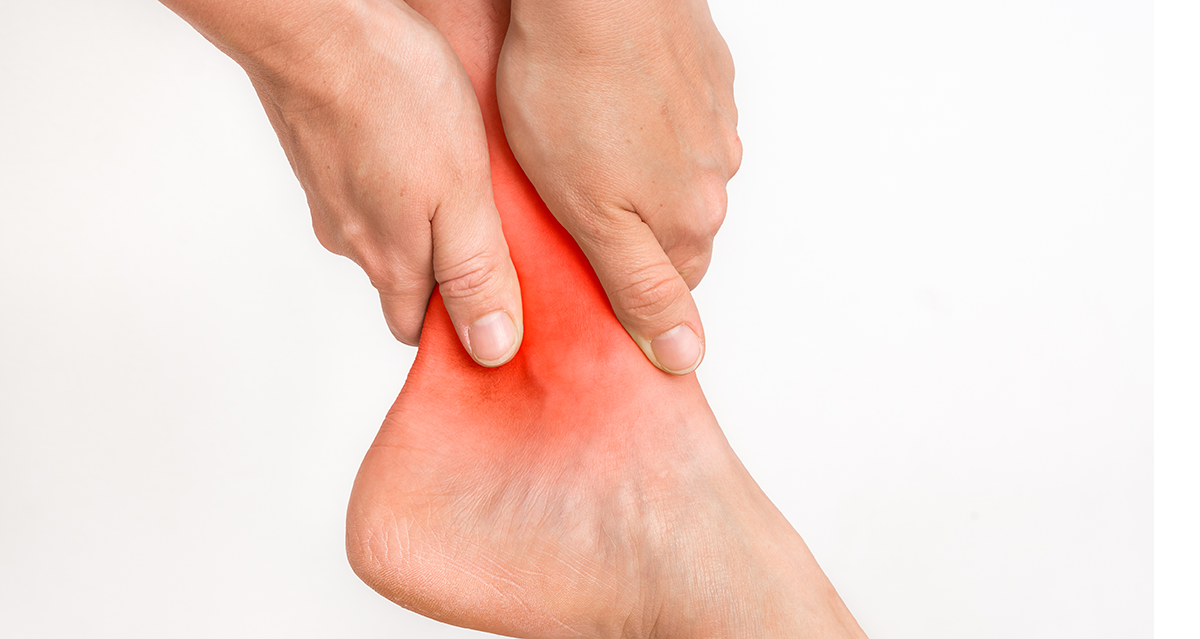Medial ankle pain signifies discomfort on the inner side of the ankle. Conditions like tendonitis (or tendinopathy), stress fractures, and nerve-related injuries contribute to chronic ankle pain, which tends to develop gradually. On the other hand, acute medial ankle pain strikes suddenly, often due to sprains, strains, and fractures.
Chronic Medial Ankle Pain: Causes and Symptoms
Chronic medial ankle pain develops gradually over time, often resulting from specific injuries or conditions. Let’s explore common causes of pain on the inside of the ankle and their associated symptoms.
Posterior Tibial Tendonitis
Posterior tibial tendonitis, also known as tendinopathy, is a primary cause of medial ankle pain, especially beneath the medial malleolus, the inner ankle bone.
Symptoms:
- Gradual pain on the inside of the ankle
- Possible radiating pain under the foot’s arch
Flexor Hallucis Longus Tendonitis
Flexor hallucis longus tendonitis or tendinopathy refers to the inflammation or degeneration of the flexor tendons in the foot.
Symptoms:
- Pain on the inner side of the ankle
- Pain along the tendon, around the back of the medial malleolus and into the foot’s arch
Medial Calcaneal Nerve Entrapment
This condition shares similar symptoms with tarsal tunnel syndrome.
Symptoms:
- Burning pain below the medial malleolus on the inner ankle
- Possible radiating pain under the sole into the foot’s arch
- Tenderness over the medial malleolus
- Aggravated symptoms during running
Tarsal Tunnel Syndrome
This syndrome results from pressure on the posterior tibial nerve as it passes on the inside of the ankle.
Symptoms:
- A burning pain in the heel, possibly radiating into the foot’s arch
- Numbness or pins and needles sensation in the sole
Talar Stress Fracture
A talar stress fracture is a hairline break of the talus bone at the ankle’s top, upon which the tibia or shin bone rests.
Symptoms:
- Gradual pain on the outside of the ankle, sometimes felt on the inside
- Exercise, particularly running, exacerbates symptoms
- Pain lessens with rest
Medial Malleolar Stress Fracture
A stress fracture of the medial malleolus, the bony bit on the inside of the ankle, is quite rare.
Symptoms:
- Pain on the inner ankle, worsened by activity, especially running and jumping
- Specific point tenderness over the medial malleolus at the fracture site
- Possible swelling, although not in all cases
- Diagnosed via bone scan, CT scan, or MRI if not visible on an X-ray
Posterior Ankle Impingement
Ankle impingement occurs when a bony growth at the ankle bone’s front or back restricts normal ankle movement.
Symptoms:
- Pain typically felt at the ankle’s back, but can appear or radiate on the inner ankle
- Tenderness behind the bottom tip of the fibula bone
- Pain worsens at the end of movement when the foot points downward into plantarflexion
- Going up onto tiptoes may be painful
- An X-ray can reveal any bony spurs on the talus (heel bone) and tibia’s end (shin bone)
Tibialis Posterior Tendon Dislocation
This dislocation of the tibialis posterior tendon is rare in sports. It happens when the tibialis muscle pulls the tendon out of its retinaculum, the tissue securing it on the inner ankle.
Symptoms:
- Moderate pain in the inner ankle
- Possible inability to bear weight on the injured ankle
- Immediate surgery is required to repair the retinaculum, followed by immobilization in a walking boot (non-weight bearing) for six weeks. An ankle brace then provides protection and support, and ankle mobility exercises can commence. However, avoid resisted inversion to prevent overstressing the ankle’s inside.
Referred Medial Ankle Pain
Pain on the ankle’s inside can stem from injuries or conditions elsewhere in the body. For instance, sciatic pain from the lower back can radiate down into the leg, and trapped foot nerves can cause medial ankle pain.
Acute Medial Ankle Pain
Acute ankle injuries happen suddenly, including sprains, strains, and fractures.
Eversion Ankle Sprain
An eversion ankle sprain happens when the ankle rolls inwards, often accompanied by a fibula bone fracture.
Ankle Sprain
A conventional ankle sprain typically causes most pain on the ankle’s outside. Still, inside ankle bone bruising can occur from compression.
Ankle Fractures
An ankle fracture is a break in any of the bones forming the ankle joint, presenting severe pain and swelling.
Read more on an ankle fracture
Critical Medial Ankle Pain Conditions to Watch
Certain injuries, while not commonly causing pain on the ankle’s inside, can lead to serious long-term damage if overlooked.
Navicular Stress Fracture
A navicular stress fracture manifests as a poorly localized midfoot ache that worsens with exercise.
Symptoms:
- Pain may radiate along the foot’s inside arch and quickly disappear with rest, only to return once training resumes
- Tenderness may be felt when the thumb is pressed into the foot’s top over the navicular bone, known as the “N spot”
Ankle Sprain Complications
Complications from ankle sprains and Complex Regional Pain Syndrome (CRPS) should not be ignored. They can lead to severe and persistent issues if not addressed promptly.

